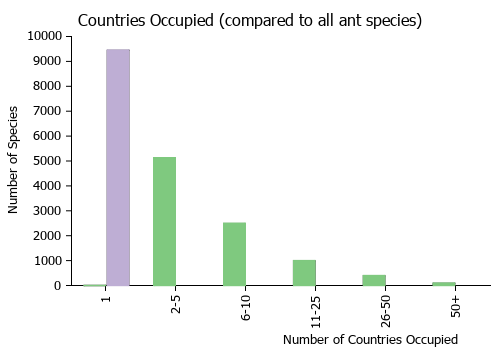Chelaner elegantulus
| Chelaner elegantulus | |
|---|---|

| |
| Scientific classification | |
| Kingdom: | Animalia |
| Phylum: | Arthropoda |
| Class: | Insecta |
| Order: | Hymenoptera |
| Family: | Formicidae |
| Subfamily: | Myrmicinae |
| Tribe: | Solenopsidini |
| Genus: | Chelaner |
| Species group: | falcatus |
| Species: | C. elegantulus |
| Binomial name | |
| Chelaner elegantulus (Heterick, 2001) | |
Chelaner elegantulus has the widest distribution of any member of the falcatus-group, and can be found throughout the drier woodland areas of temperate Australia. (Heterick 2001)
Identification
Heterick (2001) - A member of the falcatus group. This species resembles Chelaner falcatus in many morphological aspects, but is distinguished from that species by its much smaller size. Chelaner elegantulus may also be distinguished from the similar-sized Chelaner decuria by the possession of 12-segmented antennae.
Keys including this Species
Distribution
Latitudinal Distribution Pattern
Latitudinal Range: -28.46666908° to -33.85°.
| North Temperate |
North Subtropical |
Tropical | South Subtropical |
South Temperate |
- Source: AntMaps
Distribution based on Regional Taxon Lists
Australasian Region: Australia (type locality).
Distribution based on AntMaps
Distribution based on AntWeb specimens
Check data from AntWeb
Countries Occupied
| Number of countries occupied by this species based on AntWiki Regional Taxon Lists. In general, fewer countries occupied indicates a narrower range, while more countries indicates a more widespread species. |

|
Estimated Abundance
| Relative abundance based on number of AntMaps records per species (this species within the purple bar). Fewer records (to the left) indicates a less abundant/encountered species while more records (to the right) indicates more abundant/encountered species. |

|
Biology
Castes
Nomenclature
The following information is derived from Barry Bolton's Online Catalogue of the Ants of the World.
- elegantulus. Monomorium elegantulum Heterick, 2001: 380, figs. 24, 57 (w.) AUSTRALIA (Western Australia, New South Wales).
- Type-material: holotype worker, 29 paratype workers.
- Type-locality: holotype Australia: Western Australia, Mukinbudin, 25.i.1988, 374/6MonBH48 (M. Jacobs); paratypes: 13 workers New South Wales, Nyngan, 10.x.1946 (J. Armstrong), 16 workers New South Wales, Boga River (J. Armstrong).
- Type-depositories: ANIC (holotype); ANIC, BMNH, MCZC (paratypes).
- Combination in Chelaner: Sparks, et al. 2019: 232.
- Status as species: Heterick, 2009: 162; Sparks, et al. 2019: 232.
- Distribution: Australia.
Unless otherwise noted the text for the remainder of this section is reported from the publication that includes the original description.
Description
Worker
Holotype. HML 1.49; HL 0.62; HW 0.57; Cel 93; SL 0.32; SI 56; PW 0.34. Other. HML 1.51-1.81; HL 0.61-0.72; HW 0.59-0.74; Cei 95-104; SL 0.38-0.44; SI 59-72; PW 0.32-0.42 (18 measured).
As for the worker of Chelaner falcatus, but with the following apomorphies.
Head. Vertex of head capsule planar; frons densely foveate and microreticulate with combination of appressed setulae and erect and suberect setae. (Viewed from front) compound eyes set at midpoint of each side of head capsule. Longest lateral anterior clypeal setae long, extending beyond dorsal margin of closed mandibles. Posteromedial clypeal margin level with posterior surface of antennal fossae. Anterior tentorial pits equidistant between mandibular insertions and antennal fossae. Maximum number of mandibular teeth and denticles: four; apical and basal mandibular margins meeting in tooth or denticle.
Alitrunk. Promesonotum with uniform microreticulation and dorsal foveae; dorsal promesonotal face convex anteriad, otherwise flattened; erect and suberect promesonotal setae >5; setulae appressed. Mesonotal suture absent. Metanotal groove absent. Propodeal angle absent; length ratio of dorsal face to declivitous face near 2: 1. Propodeal setulae appressed.
Petiole and postpetiole. Petiolar node tumular and inclined posteriad; Ratio of greatest node breadth (viewed from front) to greatest node width (viewed in profile) near 4:3 to near 1:1. Anteroventral process always present as pronounced spur. Ventral lobe present in some individuals.
General characters. Colour light orange. Worker caste monomorphic.
Type Material
Holotype. Worker, Western Australia, Mukinbudin, 25.i.1988, M. Jacobs, soil, native veg., cara. park near town, 374/6MonBH48 (Australian National Insect Collection). Paratypes. New South Wales: 13 workers, Nyngan, 10.x.1946, J. Armstrong, Chelaner 12 seg. antennae det. R. W. Taylor 1975 (ANIC); 6 + 10 (1 head missing) workers, Bogan R., J. Armstrong, Chelaner 12 seg. antennae det. RWT. [R. W. Taylor] 1975. (The Natural History Museum and Museum of Comparative Zoology).
- Holotype, worker, Mukinbudin, Western Australia, Australia, ANIC32-015731, Australian National Insect Collection.
- Paratype, 13 workers, Nyngan, New South Wales, Australia, Australian National Insect Collection.
- Paratype, 6 workers, Bogan River, New South Wales, Australia, The Natural History Museum.
- Paratype, 10 workers (1 missing head), Bogan River, New South Wales, Australia, Museum of Comparative Zoology.
Etymology
Latin: “having a very fine appearance”.
References
- Heterick, B. E. 2001. Revision of the Australian ants of the genus Monomorium (Hymenoptera: Formicidae). Invertebrate Taxonomy. 15:353-459. (page 380, figs. 24, 57 worker described)
- Heterick, B.E. 2021. A guide to the ants of Western Australia. Part I: Systematics. Records of the Western Australian Museum, Supplement 86, 1-245 (doi:10.18195/issn.0313-122x.86.2021.001-245).
- Heterick, B.E. 2022. A guide to the ants of Western Australia. Part II: Distribution and biology. Records of the Western Australian Museum, supplement 86: 247-510 (doi:10.18195/issn.0313-122x.86.2022.247-510).
- Sparks, K.S., Andersen, A.N., Austin, A.D. 2019. A multi-gene phylogeny of Australian Monomorium Mayr (Hymenoptera : Formicidae) results in reinterpretation of the genus and resurrection of Chelaner Emery. Invertebrate Systematics 33: 225–236 (doi:10.1071/IS16080).

